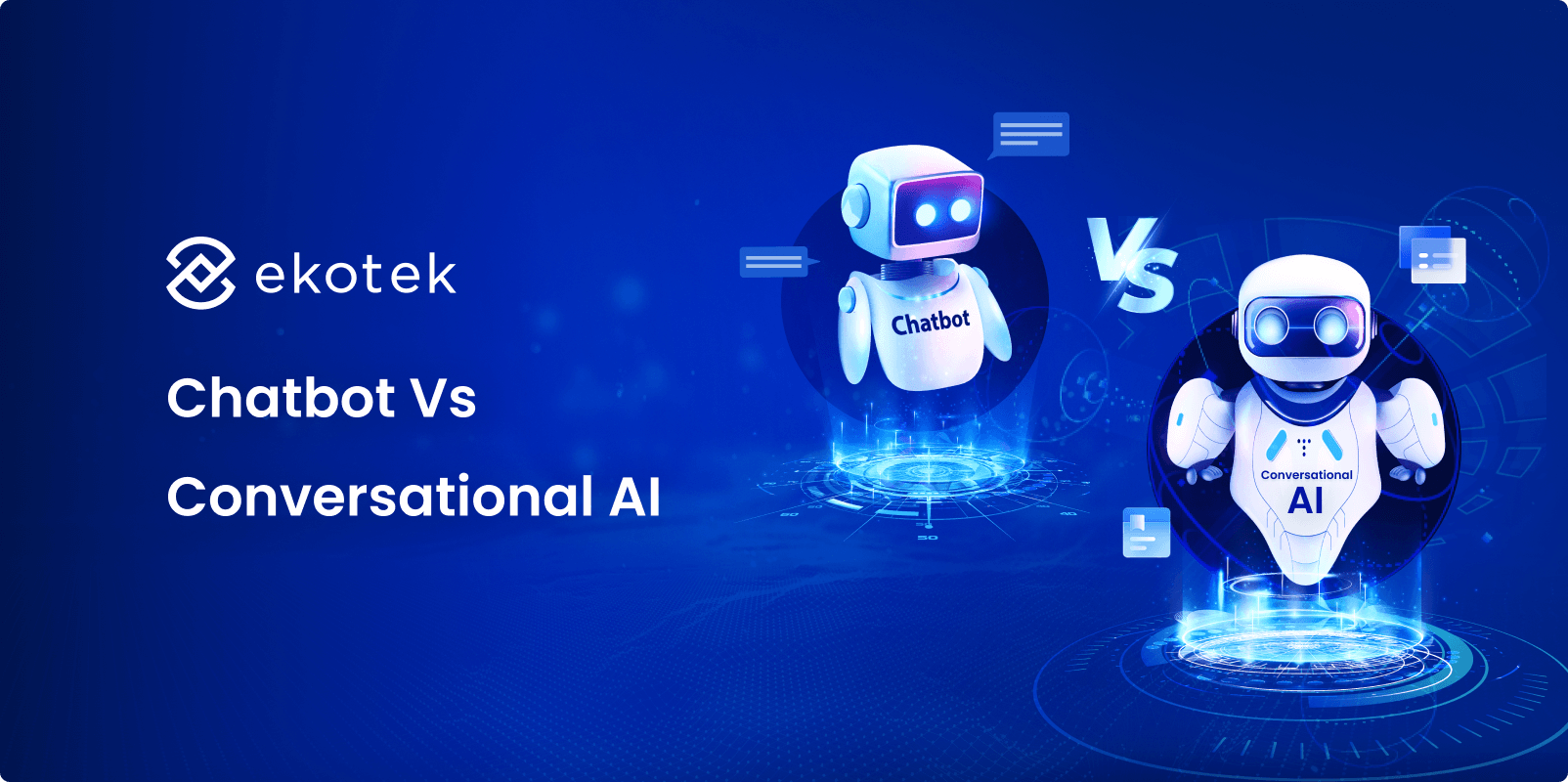
- 1
- 2
- 3
- 4
- 5
- 6
- 7
- 8
- 9
- 10
- 11
Introduction
In today’s digital-first landscape, chatbot vs conversational AI is a critical decision for B2B organizations looking to improve automation. According to McKinsey, 70% of B2B companies are investing in automation to enhance customer experience, operational efficiency, and scalability.
Despite the growing adoption of these technologies, many businesses still confuse chatbots with conversational AI, using the terms interchangeably. While they may appear similar, they serve very different purposes. Choosing the wrong solution could lead to missed opportunities and inefficient investments.
In this blog, we’ll explain the key differences between chatbot vs conversational AI, and provide insights on how to choose the right solution for your business.
Definitions and core concepts of chatbot vs conversational AI
What is a Chatbot? Understanding the Basics of Chatbots
A chatbot is a software application that simulates human conversation using predefined rules, scripts, or decision trees. It operates based on flow-based logic, responding to specific keywords or inputs with scripted replies.
Chatbots are typically used for structured, repetitive tasks such as:
- Answering frequently asked questions (“What are your business hours?”)
- Booking demos or appointments
- Guiding users through forms or simple workflows
It’s worth noting that not all chatbots are created equal. Some are purely rule-based, relying entirely on fixed scripts and decision trees. Others may incorporate basic natural language processing (NLP) to improve intent matching or keyword recognition, these are often referred to as AI chatbots.
However, even AI-enhanced chatbots are typically limited in scope and lack the deep contextual understanding, learning ability, and flexibility of full conversational AI systems.
What is Conversational AI? How it Differs from Chatbots
Conversational AI is an advanced technology that enables computers to simulate human-like conversations through a combination of NLP, machine learning (ML), and increasingly, large language models (LLMs) such as GPT or BERT.
Unlike traditional chatbots, conversational AI is designed to:
- Understand context and user intent, not just keywords
- Manage multi-turn dialogues, maintaining the thread of conversation
- Handle ambiguity or incomplete inputs, asking clarifying questions when needed
- Adapt responses dynamically based on user behavior, history, or preferences
Conversational AI powers a wide range of applications across the enterprise. These include:
- AI-powered customer support agents across chat, voice, and social channels
- Virtual assistants for internal teams (IT helpdesk, HR inquiries)
- Conversational interfaces embedded in mobile apps or self-service portals
- Voice bots and IVR upgrades for contact centers
These systems can learn from data and continuously improve over time, making them well-suited for complex, non-linear interactions across multiple channels and languages.
In essence, conversational AI powers intelligent, scalable, and personalized conversations, transforming how businesses engage with users beyond basic Q&A.
Key Differences Between Chatbot vs Conversational AI: What You Need to Know
While both chatbots and conversational AI aim to facilitate automated interactions, they differ significantly in how they work, scale, and support user needs.
- Technology stack: Chatbots rely on rules and pre-programmed scripts, whereas conversational AI leverages NLP, ML, and contextual memory to understand and adapt in real time.
- User experience: Chatbots offer rigid, linear conversations. Conversational AI provides more natural, adaptive, and multi-turn dialogue that feels closer to talking to a human.
- Scalability: Chatbots are built for narrow use cases. In contrast, conversational AI can scale across departments, use cases, and channels.
- Language handling: While chatbots match keywords, conversational AI understands full sentences, supports multiple languages, and handles ambiguity.
- Integration: Chatbots often function as standalone widgets. Conversational AI connects deeply with CRMs, ERPs, ticketing platforms, and other business systems.
- Learning ability: Chatbots remain static unless manually updated. Conversational AI learns from user interactions, improving continuously over time.
📌 Explore our practical guide to integrate ChatGPT into your system
| Feature | Chatbot | Conversational AI |
|---|---|---|
| Technology stack | Rules, scripts | NLP, ML, intent recognition, contextual memory |
| User experience | Rigid, step-by-step | Natural, adaptive, multi-turn |
| Scalability | Limited use cases | Scales across departments, workflows |
| Language handling | Basic keyword matching | Understands full sentences, supports multiple languages |
| Integration | Minimal, standalone or basic API | Deep integration with CRM, ERP, ticketing, and internal systems |
| Learning ability | Static unless manually updated | Continuously learns and improves from user interactions |
Pros and Cons of Chatbot vs Conversational AI: Which One Fits Your Needs?
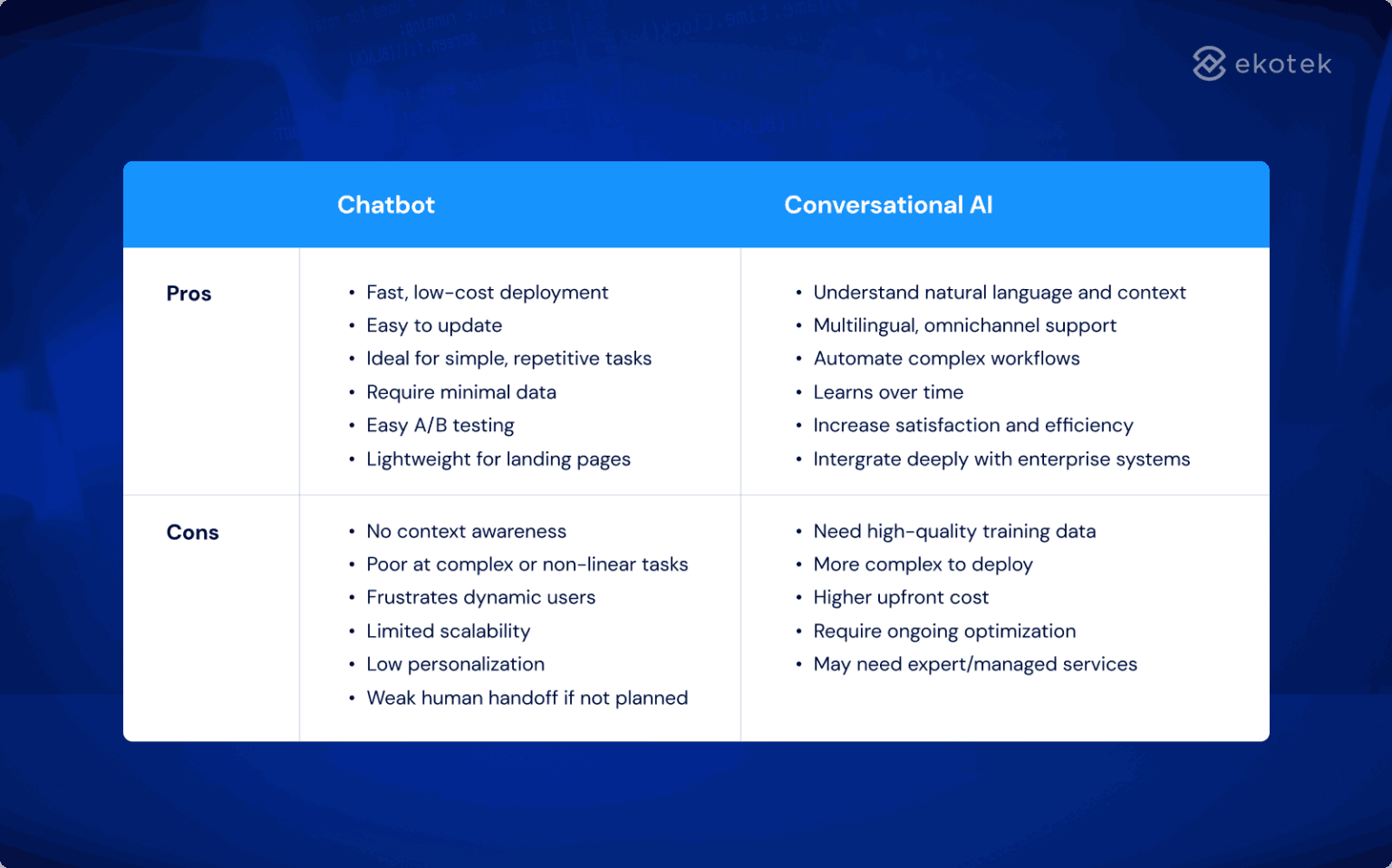
Pros and Cons of Chatbots Compared to Conversational AI
Pros
- Fast and low-cost deployment: Chatbots can be built and launched in days or weeks using simple drag-and-drop tools. This makes them ideal for businesses needing quick wins or MVP experiments.
- Easy to maintain and deploy: Since logic is rule-based, teams can make changes without deep technical skills or retraining models.
- Ideal for repetitive, transactional tasks: Perfect for tasks like booking appointments, answering common FAQs, or guiding users through simple forms.
- Require minimal training data: Unlike AI models, chatbots don’t rely on labeled datasets or user input history, just a clear flow and logic tree.
- Simple to A/B test and iterate: Easy to run variations of scripts and track conversion metrics on specific call-to-action buttons.
- Integrate well with landing pages and pop-ups: Lightweight and embeddable in marketing workflows for lead generation or micro-conversions.
Cons
- Lack contextual understanding: Chatbots can’t retain information from earlier interactions, making them unsuitable for layered conversations.
- Struggle with non-linear or unexpected inputs: If a user deviates from the script, the bot may freeze or give irrelevant answers.
- Frustrating for dynamic or high-intent users: Users with complex needs often drop off when the chatbot can’t adapt or offer relevant solutions.
- Doesn’t scale well with business growth: As workflows become more complex, managing hundreds of scripts becomes difficult and error-prone.
- Limited personalization: Cannot tailor responses to individual users beyond basic logic rules (“if user is returning”).
- Poor human handoff if not well-designed: If escalation rules aren’t implemented carefully, handovers to human agents can break the user experience.
Conversational AI Pros and Cons: Why Choose Conversational AI?
Pros
- Understand natural language and context: Can interpret full sentences, intent, and even emotions, resulting in more human-like interactions.
- Support multilingual, omnichannel engagement: Deployable across channels like web chat, voice, WhatsApp, or mobile apps, with seamless language switching.
- Automate complex, layered workflows: From onboarding new customers to triaging support tickets, conversational AI can handle multi-step, branching logic effectively.
- Learn and improve over time: Powered by machine learning, these systems improve accuracy and personalization with every interaction.
- Boost customer satisfaction and operational efficiency: By reducing wait times and resolving issues faster, conversational AI directly impacts both user experience and business KPIs.
- Seamlessly integrate into enterprise ecosystems: Can pull/push data from systems like CRM, ERP, or ticketing platforms, enabling end-to-end process automation.
📌 Explore our complete guide to AI integration and turn strategy into execution
Cons
- Requires high-quality training data: Intent recognition and conversation design rely heavily on diverse, labeled datasets to perform well.
- More complex to implement: Designing, training, and deploying a conversational AI system often involves cross-functional teams (AI, UX, business ops).
- Higher upfront investment: Licensing LLMs or custom NLP engines, plus integrations, can drive up initial costs compared to basic bots.
- Needs regular optimization: Models must be retrained periodically to stay accurate and relevant as user behavior evolves.
- Often requires expert consultation or managed services: Companies may need support from conversational AI vendors or NLP specialists to maintain and scale the system.
📌 Thinking about AI but unsure about the cost? Get a clear breakdown of how much AI costs
| Chatbot | Conversational AI | |
|---|---|---|
| Pros | - Fast, low-cost deployment - Easy to update - Ideal for simple, repetitive tasks - Require minimal data - Easy A/B testing - Lightweight for landing pages | - Understand natural language and context - Multilingual, omnichannel support - Automate complex workflows - Learns over time - Increase satisfaction and efficiency - Integrate deeply with enterprise systems |
| Cons | - No context awareness - Poor at complex or non-linear tasks - Frustrates dynamic users - Limited scalability - Low personalization - Weak human handoff if not planned | - Need high-quality training data - More complex to deploy - Higher upfront cost - Require ongoing optimization - May need expert/managed services |
Real-World Use Cases: Chatbots vs Conversational AI in Business
Chatbot Use Cases: How Chatbots Automate Routine Tasks
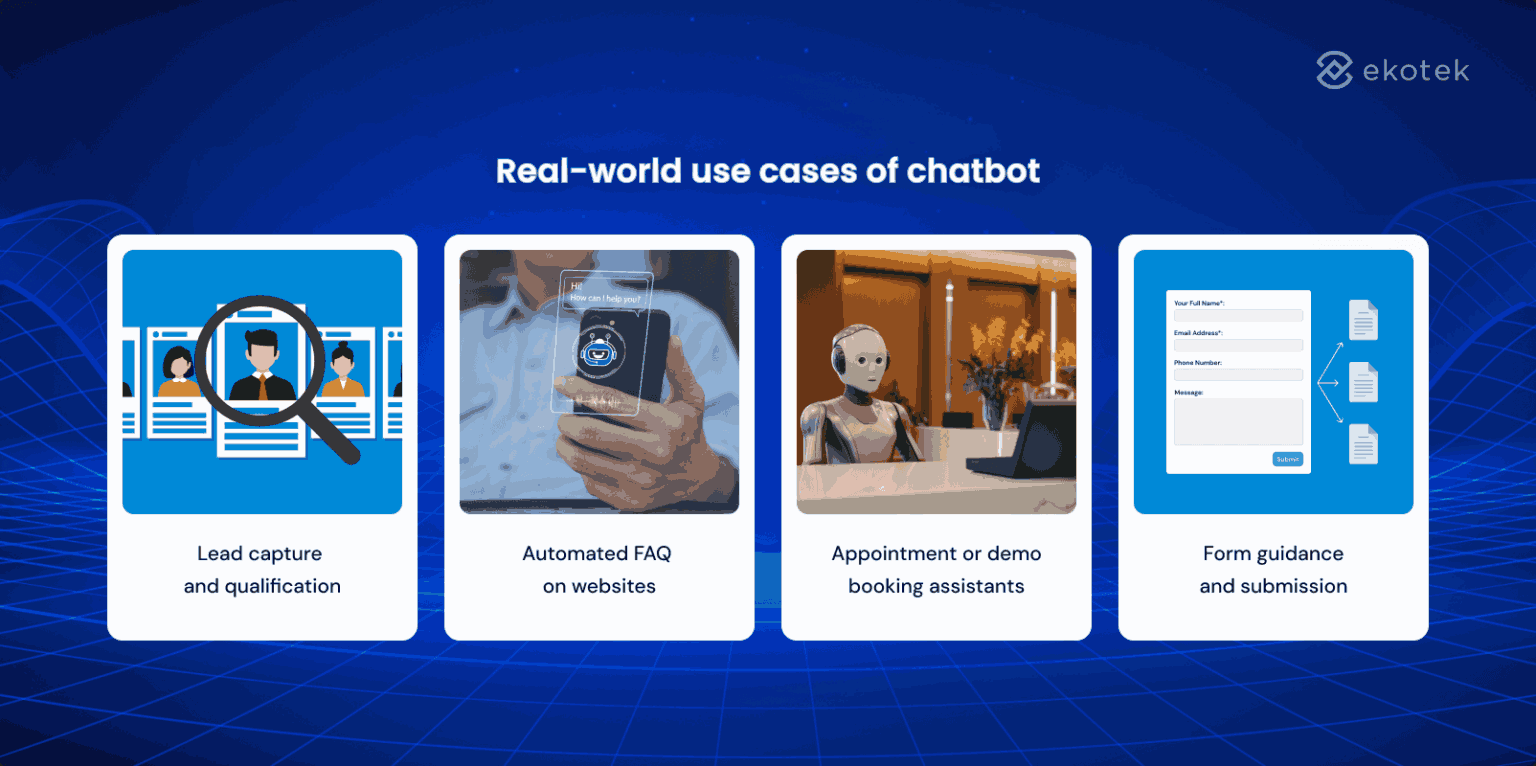
- Lead capture and qualification: Chatbots embedded on landing pages or product pages can engage visitors instantly, ask qualifying questions (company size, budget, role), and route hot leads to sales reps or calendar links automatically.
- Automated FAQ on websites: Perfect for addressing repetitive questions like pricing, support hours, or refund policies, reducing pressure on human agents while speeding up response time for prospects.
- Appointment or demo booking assistants: Instead of sending users to a static form, chatbots can guide them through a quick, conversational booking experience, resulting in higher conversion rates.
- Form guidance and submission: Used in customer onboarding or application processes, chatbots can walk users through multi-field forms, validate inputs in real time, and reduce form drop-off.
Chatbots shine in use cases that are predictable, linear, and high-volume, great for marketing and support automation at the front line.
Conversational AI Use Cases: Advanced Applications in Customer Support
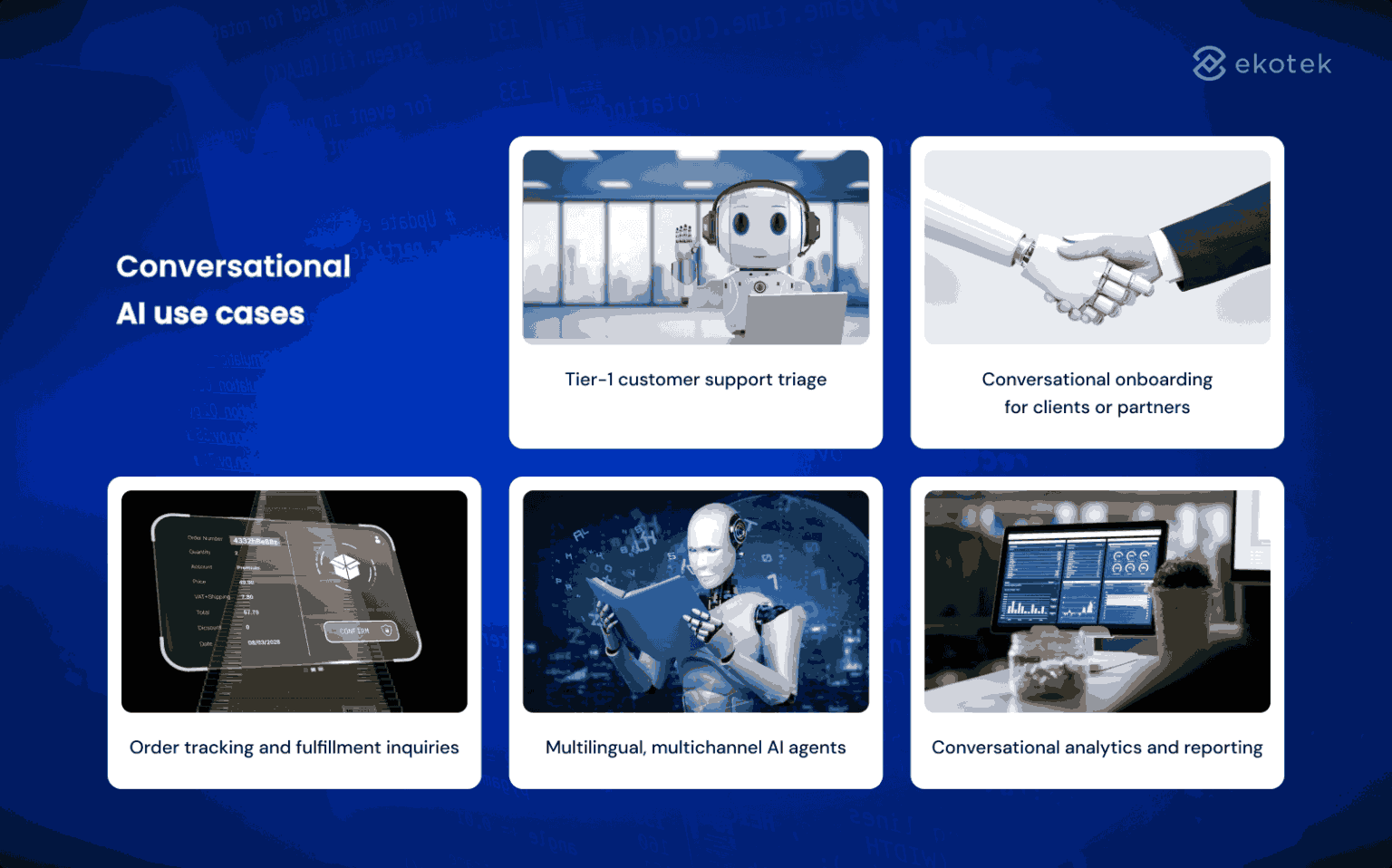
- Tier-1 customer support triage: Conversational AI can act as the first responder in support workflows, understanding a user’s intent, asking clarifying questions, and routing them to the right agent or solution path. It reduces first response time and improves agent productivity.
- Conversational onboarding for clients or partners: New users (customers, vendors, employees) can interact with AI-powered agents that explain products, set up accounts, or complete onboarding flows without manual support, creating a smoother, more scalable experience.
- Order tracking and fulfillment inquiries: Instead of having users search through emails or contact support, conversational AI can look up real-time order status, payment issues, or shipping updates by integrating directly with ERP or logistics systems.
- Multilingual, multichannel AI agents: Deploy AI assistants across WhatsApp, Messenger, voice, and web chat, while supporting multiple languages dynamically. This is ideal for global B2B enterprises or service desks with diverse customer bases.
- Conversational analytics and reporting: AI agents can not only capture feedback in natural language but also summarize, tag, and analyze trends across conversations, enabling smarter decisions in CX, product, and support.
📌 Reimagine customer service with AI. See how ChatGPT integration delivers real results
Conversational AI excels in multi-step, context-driven, and integrated workflows, where scale and personalization are both essential.
Use case comparison by industry
| Industry | Chatbot use case | Conversational AI use case |
|---|---|---|
| SaaS | Demo booking via website widget | Intelligent onboarding assistant that adapts to customer type |
| E-commerce | Product FAQ and order status inquiries | AI-powered returns/refund processing with personalized recommendations |
| Healthcare | Appointment scheduling for clinics or labs | Symptom triage assistant that supports multiple languages |
| Finance | Loan eligibility questionnaire | Conversational investment advisor with risk profiling |
| Logistics | Form-based shipment booking | Real-time delivery tracking via WhatsApp or SMS bot |
| Travel & hospitality | Hotel check-in chatbot or flight FAQ bot | Conversational travel planner that builds itineraries across channels |
How to Build Conversational AI for Your Business: A Step-by-Step Guide
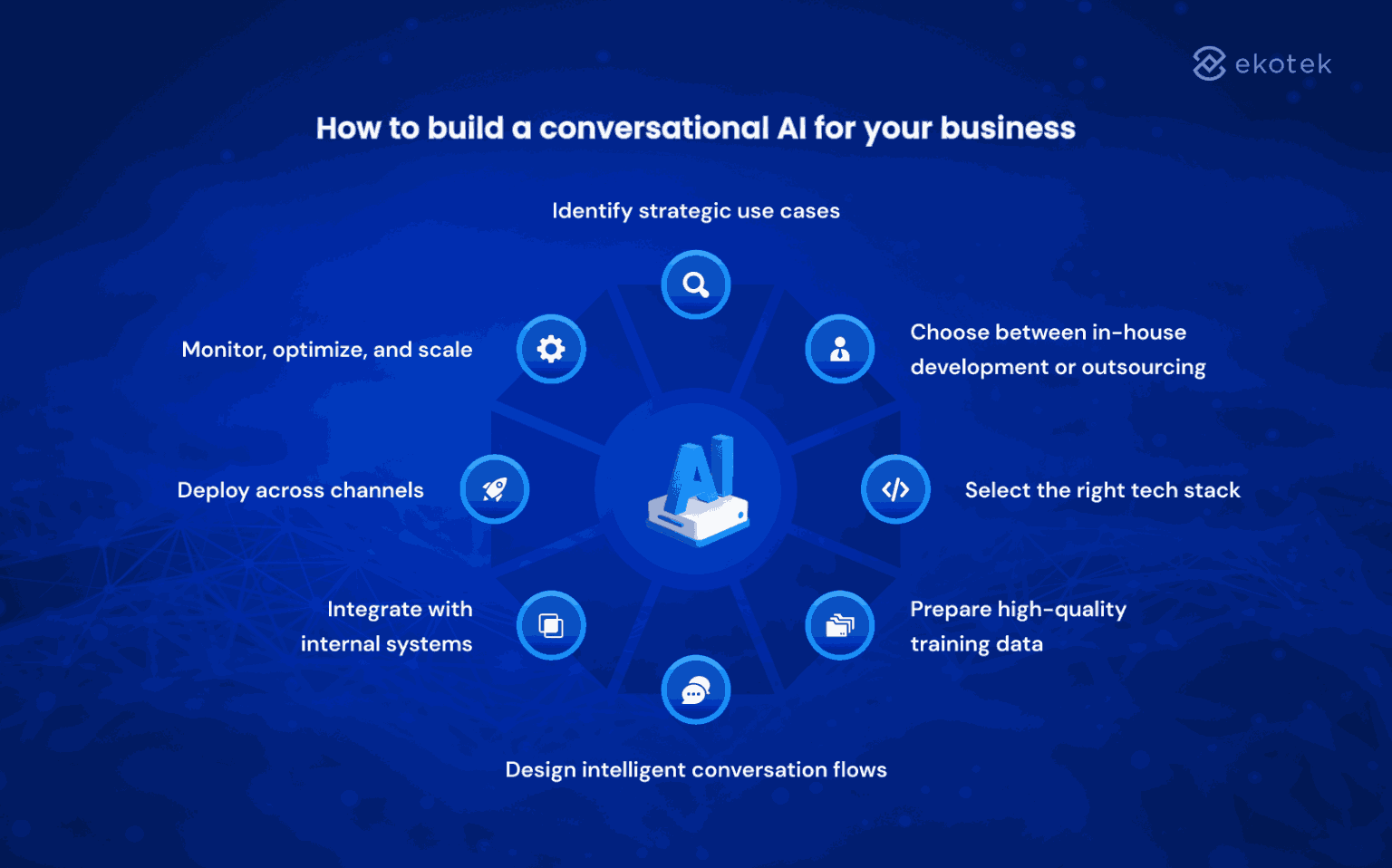
Identify Strategic Use Cases for Conversational AI
Before choosing a platform or technology, define clear, strategic use cases where conversational AI can create a measurable impact. These may include:
- Reducing support load through automated tier-1 triage
- Improving lead qualification and conversion
- Scaling multilingual customer engagement
Every use case should tie back to a business metric, such as lowering resolution time, increasing NPS, or improving conversion rates. This helps build internal alignment and justify investment from the start.
Choose Between In-House Development or Outsourcing Conversational AI Solutions
Decide whether to build in-house or partner with an AI solutions provider. Building internally may offer greater control, but requires deep expertise in NLP, UX, and integrations. Outsourcing can accelerate time-to-value and reduce risk, especially if you’re exploring AI for the first time.
A strong partner brings more than just technical tools, they offer domain expertise, conversational design capabilities, and operational support to ensure long-term success.
📌 Discover why outsourcing AI makes sense for enterprises.
Select the Right Tech Stack for Conversational AI
The right technology stack will depend on your use case complexity, user channels, and integration requirements. Consider platforms that combine:
- LLM (GPT-4, Claude, Gemini)
- Intent engines and dialogue managers (Rasa, Dialogflow)
- Orchestration layers to manage conversations across channels
Ensure your tech stack supports context handling, real-time data integration, and enterprise-grade compliance and security.
📌 You may be interested in LLM chatbot
Prepare high-quality training data
Conversational AI depends heavily on high-quality, domain-specific data. Start with:
- Historical support chats, emails, or call transcripts
- Intent classification examples from real users
- Business FAQs, documentation, or knowledge base content
A structured dataset with clearly labelled intents and edge cases will directly impact the system’s ability to understand and respond accurately.
Design intelligent conversation flows
Instead of rigid flows, design conversations that mimic how humans naturally interact, including follow-up questions, clarifications, and exceptions. This includes:
- Contextual memory (last order, previous inquiry)
- Fallback handling (when the bot doesn’t know)
- Escalation paths to human agents when needed
Strong conversational UX is often the difference between user delight and abandonment.
Integrate with Internal Systems for Conversational AI
To move beyond surface-level automation, conversational AI must be deeply connected to your business ecosystem. Integrate with:
- CRM: for personalisation and context
- ERP: for live inventory or order status
- Support and ticketing platforms: for case updates and routing
This turns your AI from a reactive support tool into a proactive, data-aware assistant that drives business outcomes.
Deploy Conversational AI Across Multiple Channels
Modern users interact with businesses across multiple platforms, and they expect consistent, seamless experiences wherever they are. Your conversational AI should be designed to support a truly omnichannel presence, including:
- Web chat widgets embedded in websites or product pages
- Mobile apps, both iOS and Android
- Messaging platforms like WhatsApp, Facebook Messenger, or Telegram
- Voice interfaces, including IVR systems or smart assistants like Alexa and Google Assistant
To maintain user trust and engagement, ensure your system offers conversational continuity, so a user can start a conversation on one channel and continue it elsewhere without losing context.
Monitor, Optimize, and Scale Conversational AI Solutions
Launching conversational AI is just the beginning. Long-term success depends on your ability to continuously monitor performance, optimize interactions, and scale use cases as your business evolves.
Focus on:
- User satisfaction and experience quality, using metrics like CSAT, NPS, or task completion rate
- Fallback and error rates, identifying where the system fails to understand or respond appropriately
- Retraining and model tuning, incorporating new user inputs and updating outdated intents
- Expanding intent coverage, as business needs and customer questions evolve
- Conversational analytics, to uncover trends, gaps, and automation opportunities
Scaling conversational AI is not about adding more bots, it’s about deepening capability, broadening reach, and continuously aligning with strategic business goals.
When to Use Chatbot vs Conversational AI: Choosing the Right Solution
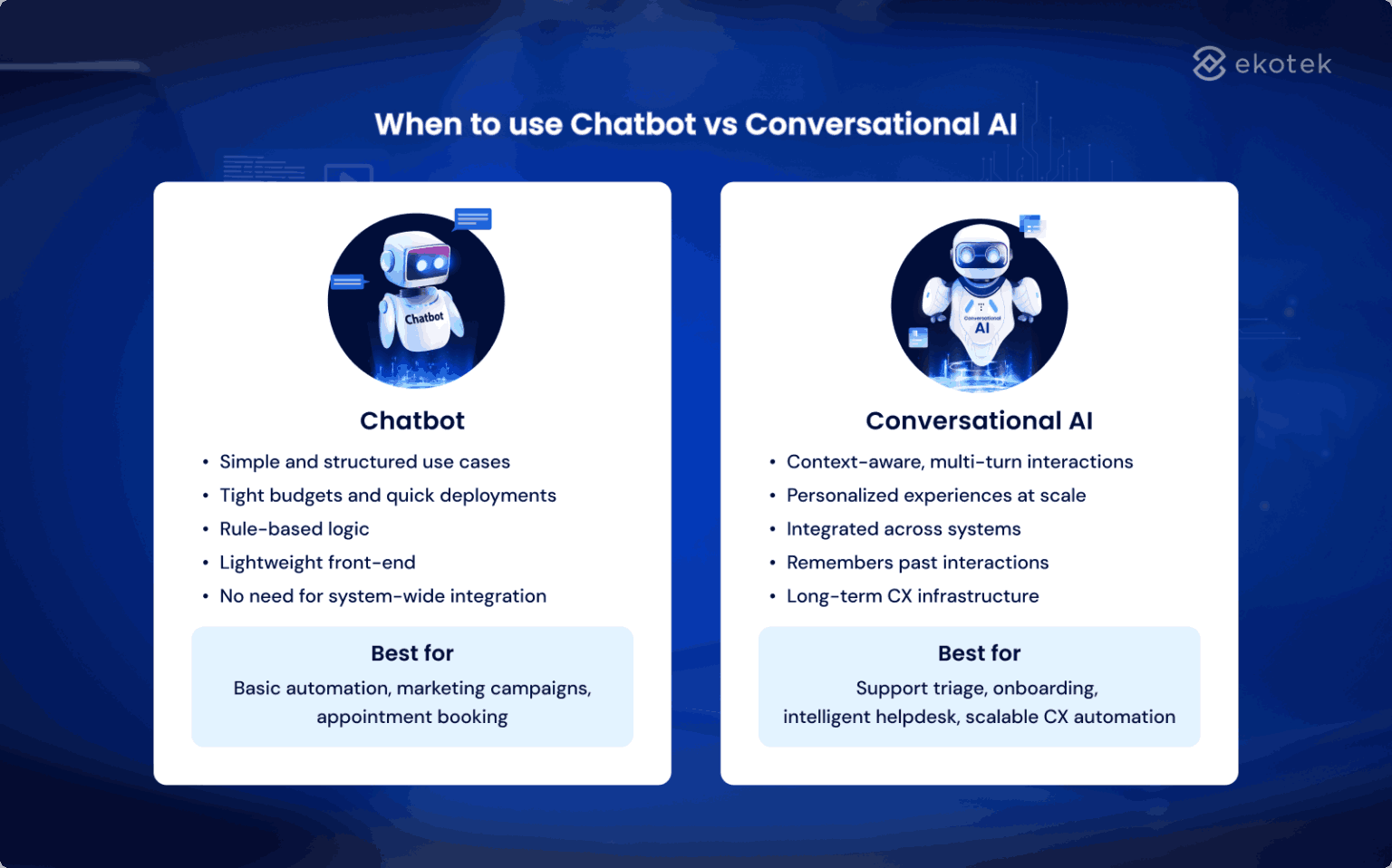
Use a chatbot when:
- Your use cases are simple and structured: Ideal for FAQs, appointment bookings, lead capture, and basic form guidance, where conversation paths are predictable and repetitive.
- You’re working within tight budgets or timelines: Chatbots can be deployed quickly using no-code or low-code platforms, offering a fast path to automation without major technical investment.
- Personalization and advanced logic aren’t critical: If your interaction doesn’t require memory, historical data, or contextual awareness, rule-based flows will suffice.
- You want a lightweight front-end experience: Especially effective for marketing campaigns, landing pages, or one-time lead engagement tools.
Use conversational AI when:
- You need context-aware, multi-turn interactions: For example, support triage, onboarding, or internal helpdesk flows that require the system to remember past steps and adapt dynamically.
- You want to personalize experiences at scale: AI systems can use CRM data, user behavior, and language preferences to tailor conversations in real time.
- Your workflows span across systems and channels: Conversational AI integrates with ERPs, CRMs, and ticketing tools, turning a static chatbot into a powerful business assistant.
- You’re investing in long-term CX infrastructure: For organizations prioritizing automation, self-service, and omnichannel experiences, conversational AI forms the foundation for scalable, intelligent interactions.
Future Trends in Conversational AI: What’s Next for Intelligent Systems?
As conversational AI technology advances, we’re seeing a shift from basic scripted bots to intelligent, context-aware digital agents. These emerging trends are shaping how enterprises automate interactions, streamline workflows, and deliver more personalized experiences:
Fusion of generative AI and intent-driven systems
Combining LLM with traditional intent-based architectures allows for more natural, flexible conversations. Enterprises can build AI agents that both understand user intent and generate human-like responses, striking a balance between creativity and control. This unlocks new possibilities for smarter, more engaging customer interactions.
📌 Confused between generative AI and agentic AI? This guide clears it up
Rise of voice-first interfaces
Voice is rapidly becoming the preferred entry point for digital experiences. Companies are modernizing IVRs and call centers with voice-enabled conversational AI that can understand tone, emotion, and context in real time. For industries with high call volumes like banking, telecom, and healthcare, this translates into faster resolutions and improved customer satisfaction.
Unified agent frameworks across channels
Rather than deploying separate bots for web, mobile, and messaging platforms, businesses are adopting centralized agent frameworks. A single AI engine can now power multiple touchpoints, from websites to WhatsApp to phone, maintaining context and delivering a consistent experience throughout the customer journey. This improves operational efficiency and reduces fragmentation.
📌 Dive into the differences between AI agent vs chatbot
Retrieval-augmented generation (RAG) for enterprise knowledge
RAG enables AI to generate responses based on real-time access to internal data sources, such as knowledge bases, product manuals, or policy documents, rather than static training. This empowers virtual agents to deliver accurate, up-to-date answers for support, onboarding, and compliance use cases, reducing the need for human intervention.
Conversational AI as a strategic enterprise layer
Conversational AI is evolving into more than a support tool, it’s becoming part of the enterprise operating model. Leading organizations are using it to automate internal workflows, connect siloed departments, and enhance decision-making. As AI becomes embedded into core systems, it drives long-term value across the business.
Ekotek’s Conversational AI Solutions for Smarter Business Operations
One standout example of conversational AI in action is Ekotek’s project with NFTify, a no-code NFT marketplace. Faced with fragmented support content and limited agent availability, NFTify needed a smarter, more scalable solution.
Ekotek built a contextual AI chatbot, improving self-service by combining:
- Knowledge integration: It’s trained on live content like FAQs, policies, and documentation.
- Intent recognition: It understands diverse user queries and responds with contextually accurate answers.
- Multilingual capability: It detects and replies in the user’s preferred language.
Outcomes:
- 24/7 automated support
- Reduced load on human agents
- More consistent and relevant customer experiences
📌 Get the full story behind NFTify’s AI-powered transformation
Final Thoughts on Chatbots vs Conversational AI: Making the Right Choice
As automation becomes central to digital transformation, understanding the difference between chatbots and conversational AI is no longer optional, it’s a strategic necessity. Chatbots offer fast, rule-based solutions for simple tasks, while conversational AI redefines how businesses engage, support, and scale through intelligent, context-aware interactions. By recognizing their distinct strengths and choosing the right fit for each use case, organizations can move beyond automation as a cost-saving tool, and turn it into a driver of long-term value.
Ekotek specializes in building intelligent AI solutions that go beyond the hype, delivering real impact, fast. Whether you’re just starting your AI journey or scaling existing initiatives, we offer end-to-end support from strategic advisory to full-scale development and integration.
With deep expertise across industries like manufacturing, finance, retail, and education, our team brings the right blend of technical skill and domain insight to help your business automate smarter, engage better, and grow faster.
Frequently Asked Questions (FAQs)
1. What is the primary difference between a chatbot and conversational AI?
A chatbot typically follows predefined scripts to handle simple, repetitive tasks like answering FAQs or booking appointments. In contrast, conversational AI utilizes advanced technologies such as Natural Language Processing (NLP) and Machine Learning (ML) to understand context, manage multi-turn dialogues, and adapt responses dynamically based on user behavior and preferences.
2. How can conversational AI enhance customer service for businesses?
Conversational AI can provide personalized, human-like interactions across various channels, including chat, voice, and social media. It enables businesses to handle complex customer inquiries, offer tailored solutions, and maintain consistent communication 24/7, thereby improving customer satisfaction and operational efficiency.
3. Is implementing conversational AI cost-effective for enterprises?
While the initial investment in conversational AI may be higher than traditional chatbots, the long-term benefits include reduced operational costs, improved customer retention, and scalability across multiple departments and channels. This makes conversational AI a cost-effective solution for enterprises aiming for sustainable growth.
4. Can conversational AI integrate with existing business systems?
Yes, conversational AI can seamlessly integrate with various business systems such as Customer Relationship Management (CRM), Enterprise Resource Planning (ERP), and ticketing platforms. This integration allows for a unified approach to customer interactions and data management, enhancing overall business operations.
- 1
- 2
- 3
- 4
- 5
- 6
- 7
- 8
- 9
- 10
- 11